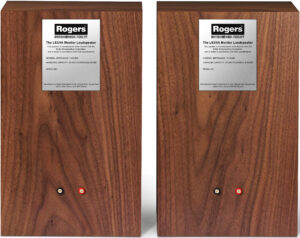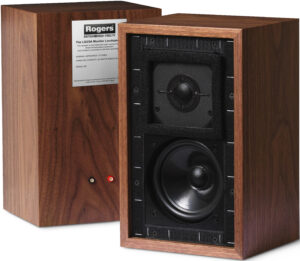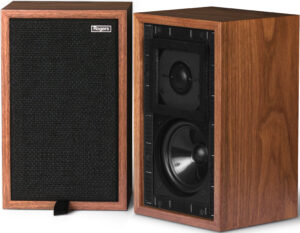Rated at 82 dB of output at one watt at one meter into 15 ohms, the Rogers required considerable power to produce 82 dB of volume, and even more so if made to produce high sound pressure for an audience sitting three meters away. For the Rogers high impedance and low sensitivity translates into lower amplifier power, and in many instances considerably less than half of the rated 8-ohm output of a given amplifier is obtained. As an example, the Pass Labs INT-250 integrated amplifier’s otherwise specified 250 watts of output into an 8-ohm load likely produced approximately 30 watts per channel into the 15-ohm load, per Desmond Harrington, president of Pass Labs.
The Pass Labs XA200.8 pure class A monoblocks thus came to the rescue, and they energized the Rogers into delivering frighteningly high volume in recreating the powerful dynamics and bass drums in the 2014 Alexandre Desplat soundtrack to Godzilla on vinyl. The bottom-end as sourced from the Pass Labs XS Phono fed by the Top Wing Suzaku coreless straight-flux cartridge on the Clearaudio Master Innovation turntable reached down to at least 70 Hz in-room, and both cartridge and speakers continued to keep track of the modulations unfazed. Integration of the drivers was spot-on.
The Roger’s recreation of the vast pipe organ in the Proprius demonstration disk of Cantate Domino also produced a dynamic scaling exuberant and unheard of for its asking price. The stage was well delineated and stable, prompting repeated marveling at the unveiled, delicate looking drivers. But no existing small drivers in the physical universe can handle bottom-ends like the Sound Lab electrostatic panel, or a 15-inch woofer. The lofty goal has been attempted by manufacturers of multi-driver speakers to this day and the results are largely unconvincing thus far.
The Rogers didn’t do well with rock music that emphasized strong electric bass and kick drum. It was when I heard the mini-monitors play classical and acoustic music that I realized that I had misused them. These are meant for near-field monitoring in a mobile studio in a minivan and here I am playing them loud, driving them with powerful amplification in a large room. Talk about pushing a disoriented ballerina onto a rock concert stage.
This is also probably where LS 3/5a loyalists would cry foul, for they would pamper the speakers rather than subjecting them to wanton sonic spectacles. And I understand completely, for I also pulled the Rogers 50% closer to the listening position later, with the same toe-in, and way out into the center of the listening room, and this was where the real magic happened. On top of that, I put the Margules Audio u-280SC Black ultralinear/triode tube monoblocks onto the Rogers, and at moderate levels, and the tonal transparency and definition was reminiscent of the vast Sound Lab panels albeit on a smaller scale.
Okay, the Rogers did not approach the electrostatic panels on volume or scaling, but this experience gave rise to a new hope. For when positioned away from walls and arranged in the near field, the Rogers were not required to scream and the tonal balance improved and was on perfect point whether it was a solo piano or a large orchestra with complex intonations playing. Even the Burt Bacharach soundtrack to Butch Cassidy and the Sundance Kid from the seventies sounded pristine and definitive, with a midrange clarity (aided by the Margules monoblocks) to die for. The Margules in mono triode mode pumps out 55 precious watts per channel into 8 ohms, and it was more than enough in this setting. If you want to experience a very three-dimensional soundstage with realistic instrument portrayal, near field listening with the Rogers is how you do it.
Near field listening can be an ideal setting to harness low-level details even at low sound levels from the Rogers, but the Rogers LS 3/5a Classic also had limitations. While its specified 80 Hz bottom-end was otherwise expeditious and tuneful, very well behaved, and more accurate than all mini-monitors I have auditioned in the last five years, the subtly audible but powerful tympani and bass drum in the Sibelius tone poem Swan of Tuonela were inaudible via the 4.3-inch Rogers midrange/woofer.
The last phase of the auditioning saw me driving the Rogers with a class D, ICEpower-ed, $2,899 Wyred 4 Sound STI-1000 v2 integrated amplifier, sourcing from the $3,300 Aurender N100SC caching music server/streamer and the $8,000 Bricasti Design M1 dual-mono USB DAC. The real surprise was the class D amplifier, outputting 460 watts per channel into 8 ohms, sounding smooth and detailed through the Rogers; it’s a real world solution for readers on a budget. High-quality source is still a prerequisite but this experience informed me of how much of a gem the Rogers are.
As of this writing, I have auditioned five pairs of mini-monitors of various makes within a 24-month period. The models were priced respectively at $399, $995, $1,050, $1,999 and $4,000 the pair, and they all but the $399 model gave me pause. One model used exotic tweeters but the midrange didn’t blend; another featured ultra-stiff and light drivers and was reportedly trusted by some recording studios but was otherwise bland sounding and the drivers had varying dispersion characteristics. The $4,000 pair employed costly drivers and crossover network but it sounded no better than the $1,050 model at one-fourth the price. A particular model suffered from an excess of personality such that whatever source and amplification put to it sounded the same. The $399 model was the Audioengine HDP6. Spending more than $399 on any of the other contenders seemed a waste of money until now, because the Rogers LS 3/5a Classic is of true reference caliber and it costs only $3,350.
The Rogers was very well balanced in attributes and priced centrally amidst the others I auditioned. The pair behaved much less cantankerously and mendaciously than the rest. When some mini-monitors can get downright noisy, the Rogers was the exact opposite of them with a clean spectral presentation and an absence of aggressive shrilling.
Tonality-wise, super monoblock amplifiers like the Pass Labs XA200.8 and Bricasti Design M28 were highly complementary with the Rogers, inducing delicate but stately demeanor from the mini-monitors. Crescendos and fortissimos became the specialty of the Rogers in such arrangements, even in the relatively vast space, and orchestral passages from either classical or Hollywood sources drew me into vast, inspiring presentations. I was impressed with the Rogers’ ability to portray strings and woodwinds in orderly fashion on a vast canvas. And all for $3,350.
Analog playback through the Rogers was particularly enticing. Opposite my reference Sound Lab panels in large spaces, the diminutive Rogers projected vast sound fields and wholesome spectral spreads in the nearfield setup, a feat the other, aforementioned mini-monitors achieved at much lesser capacity, and it kept me playing one record after another. While the vast Sound Lab panels elicited a grounded presence in analog playback that I never experienced with other speakers before, the Rogers accomplished it in tight spaces just as spectacularly. An audiophile is acutely aware of his highly acclimated and trained ears and goes to great lengths to create an engrossing, enveloping music experience that only a properly setup sound system can provide.To be an audiophile is to play the music just to ravish in its presence.
Auditioning the $25,000 Sound Lab Majestic 645 electrostatic panel loudspeakers was exciting and category defining, constituting the most perfect platform for reproducing instruments large and small, from a lone flute or female vocal to a piano and taiko drum in a large listening space. But reviewing the Rogers LS 3/5a Classic was even more exciting, for now readers living in tighter quarters can enjoy truly high-end sound for a comparative pittance.
In recent memory, the similarly two-way, ported, full-range Audio Note UK AN-E SEC Silver that I used to own came closest to the Rogers LS 3/5a Classic in creating a seamless spectral presentation, especially in near field listening. In case you don’t know, Audio Note UK does have a two-way infinite baffle design named the AN-K D, starting at $2,690 the pair on top of a pair of matching, $640 stands. What are the odds…
Still, just as the $25,000 Sound Lab Majestic 645 electrostatic panel loudspeakers are the lowest-priced option to experiencing the sound of a live orchestra next to the $185,000 Acapella Triolon Excalibur, the Rogers HiFi LS 3/5a Classic bookshelf speakers are the least expensive product that I know of that can deliver a full and engaging music experience for as little as $3,300.
Small speakers are limited by their physique and I have yet to audition one that is of such superlative design and performance that a separate, outboard crossover box is utilized. But two-way small speakers are not expected to deliver the same volume as full-range floorstanders, and that very limitation is a blessing in disguise. Even then, I have auditioned bookshelf speakers from companies big and small in the past few years and the Rogers is the first pair that warrants a formal review.
Accurate speakers are an essential editing and mastering tool, and some designs I auditioned were revered by professional studios but tonally boring to my audiophile sensibilities. Food without flavor is not nice. The new Rogers LS 3/5a 15-ohm is accurate enough to reveal changes upstream and is full of flavor, and listening to it play music is quite an experience. Speakers of the Rogers caliber and stature selling for $3,350 the pair accords everyone the opportunity to experience the BBC sound at least once in your lifetime.
Whether the Rogers are for you or not depends ultimately on how susceptible you are to the temptation for “more and better.” The Rogers are not the ideal candidate for the most powerful playback even in a medium-sized room, nor are they the most extended in frequency response. Instead, the Rogers will show you music reproduction as a pair of the most proper and high value bookshelf speakers in high-end audio history.
Few products cure the upgrade bug, but many a fellow audiophile I have come to know throughout the years settled for nothing but the BBC monitor. For readers on perpetual upgrade paths, the Rogers may just be what the doctor ordered. Considering its professional lineage, continued affordability, and the vast number of music lovers having derived immense listening pleasure from it, the now reborn Rogers LS 3/5a Classic is a giant. Just as the Sound Lab is my full-range reference, the Rogers LS 3/5a Classic is my bookshelf reference against which all will be judged.
Copy editor: Dan Rubin
Review system:
PS Audio DirectStream Power Plant 20 AC regenerator
Acoustic Sciences Corporation TubeTraps
Audio Reference Technology Analysts EVO interconnects, power cable
Audio Reference Technology Analysts SE interconnects, power cables
Audio Reference Technology Super SE interconnects, power cables
Clearaudio Master Innovation turntable system with SmartPower 24V battery power supply
AMG 12J2 tonearm
Stealth Audio Cables Helios phono cable
47 Laboratory 4741 Izumi CD player
Audio Research DAC 9
Bricasti M1 dual-mono DAC
Bricasti M21 dual-mono DAC
Esoteric K-01XD SACD player/USB DAC
Esoteric G-01 rubidium clock
Clearaudio Absolute Phono
Pass Laboratories Xs Phono
Van den Hul The Grail SE Phono
Pass Laboratories Xs Preamp
Pass Laboratories XA200.8 pure class A monoblocks
Bricasti Design M28 class AB monoblocks
Margules Audio u-280SC Black ultralinear/triode tube monoblocks
Sound Lab Majestic 645 electrostatic panels
- ← Previous page
- (Page 2 of 2)




It sounds like you had a great time with them, especially after you got to know them. Hope I have a chance to hear a pair someday
Rogers ls3/5a new classic end of mini monitors
I remember selling these for $500/pr. That’s a lot of inflation.
Does it make sense to have a quite old pair of these speakers cleaned or even reconditioned?
Dear Joe,
Thank you for your comment and readership.
I’d advise contacting the factory on the cost of reconditioning a pair of old LS 3/5a. But be advised that the sound of a new pair of speakers will sound differently from an old pair of the same model where the drivers’ and crossover’s conditions are concerned.
We naturally attach considerable sentimental value on objects, speakers included, and an endearing pair of Rogers LS 3/5a is understandably hard to part with. Still, speaking rationally, a fresh pair will always present a more accurate sound than a very old pair as the drivers and crossover electronics get old and no longer perform even close to the original specifications.
Musical enjoyment is fundamentally personal, and emotional. No need to struggle if you find it hard to part with your old pair. Clean it, recondition it and keep enjoying it.
Sincerely,
Constantine